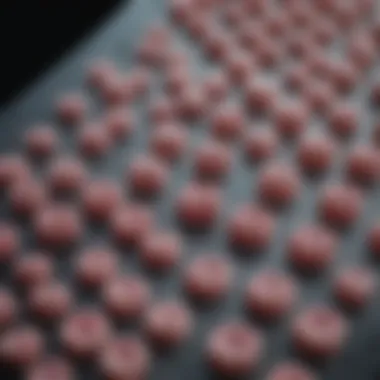Exploring Tissue Arrays: Methodologies and Applications


Intro
Tissue arrays have emerged as an essential technology in biomedical research, particularly for understanding disease mechanisms, drug development, and the complexity of human tissues. By allowing multiple samples to be analyzed simultaneously, tissue arrays optimize resource use and enhance data throughput. This section provides a foundational introduction to the overall relevance and importance of tissue arrays in contemporary scientific inquiry.
As researchers increasingly recognize the value of this methodology, they can better navigate the landscape of cancer research and therapeutic development. The ability to extract simultaneous insights from varied tissues presents a significant advantage compared to traditional methods. This article will unpack these methodologies, discuss their applications, and outline potential future directions for tissue arrays.
Understanding Tissue Arrays
Understanding tissue arrays is crucial in the realm of biomedical research. Tissue arrays provide a method to analyze multiple tissue samples in a compact format, making it a significant advancement in pathology and diagnostic research. They save time and resources compared to traditional methods. This systematic approach enhances the ability to conduct extensive research on various biological samples concurrently.
Definition and Purpose
Tissue arrays are precisely organized collections of tissue specimens. These specimens can derive from various diseases, conditions, or organism samples and are embedded in a single paraffin block or glass slide. Their main purpose is to facilitate high-throughput analysis of specific markers, proteins, or genomic information within a wide array of tissues in minimal measurable space. They allow researchers to conduct comparative studies across different samples efficiently. By using tissue arrays, it is possible to observe the reaction of healthy versus diseased tissues side by side, which can significantly enhance the understanding of pathologies.
Historical Context and Development
The development of tissue arrays dates back to the late 20th century when the need for improved diagnostic techniques became apparent. The introduction of tissue microarray technology in the late 1990s marked a significant turning point. Initially, researchers primarily used this technology for studying cancer. Over the years, the methodology evolved, driven by advancements in molecular biology and imaging technologies. As research demands increased, so did the complexity and design of tissue arrays.
Today, a variety of tissue array types exist, ranging from simple microarrays to high-density arrays incorporating many samples. These innovations catering to specific research needs have gained traction not only in oncology but across multiple biomedical fields. Understanding this historical context helps appreciate the significance of tissue arrays in contemporary research and their potential for future advancements.
Types of Tissue Arrays
Tissue arrays offer a diverse range of methodologies that enhance the efficiency and accuracy of biomedical research. Understanding the different types of tissue arrays enables researchers to better adapt their studies to specific needs and conditions. Each type, while serving similar fundamental purposes, has unique techniques and applications. Exploring these types is vital as they open doors to advanced diagnostic and therapeutic strategies that can significantly impact patient care and research outcomes.
Tissue Microarrays
Tissue microarrays (TMAs) are compact collections of tissue samples organized onto a single slide, typically created from formalin-fixed, paraffin-embedded tissues. This method facilitates high-throughput analysis, allowing researchers to examine numerous samples simultaneously, thus drastically reducing time and resource consumption. TMAs have gained prominence in cancer research, allowing for the comparative study of biomarker expression across different tumor types.
The construction process involves
- Core sampling from donor blocks,
- Arranging these cores into a new recipient block, and
- Cutting thin sections for analysis.
Researchers often incorporate TMAs for immunohistochemistry, enabling them to visualize protein expression levels in numerous samples at once. This benefits both biomarker discovery and therapeutic target identification.
Arrayed Imaging Technology
Arrayed imaging technology enhances the capabilities of traditional tissue arrays by integrating sophisticated imaging techniques. This method employs high-resolution imaging systems that capture detailed spatial information from the tissue samples. Using such imaging methods helps researchers analyze the morphology and distribution of specific proteins or other biomarkers more accurately.
One distinct advantage is the ability to overlay biological data with anatomical structure. This leads to more meaningful interpretations in studies, particularly in relation to tumor microenvironments. The ability to visualize and quantitate spatial relationships in tissue samples can yield insights that traditional techniques may overlook. The integration of next-generation imaging modalities continues to evolve the landscape of tissue analysis.
High-Density Tissue Arrays
High-density tissue arrays represent the latest advancement in the realm of tissue array technology. These arrays contain a significantly larger number of samples per slide, facilitating a broader scope of investigations at a reduced cost per sample. By maximizing the sample coverage, high-density arrays enhance statistical power and allow researchers to conduct large-scale studies with relative ease.
One application of high-density tissue arrays is in cancer genomics, where they can be used to evaluate the relationship between genetic alterations and clinical outcomes. Moreover, they can serve as platforms for drug screening, allowing researchers to examine drug responses across multiple cancer types simultaneously.
The increased data density necessitates optimized analytical techniques. This might include bioinformatics approaches to process vast amounts of data efficiently, ultimately leading to more reliable and comprehensive insights.
Methodologies for Creating Tissue Arrays


Creating tissue arrays involves a set of intricate methodologies that are vital for leveraging their full potential in biomedical research. Understanding these methodologies ensures not just the successful construction of tissue arrays but also enhances the reliability of the data they provide. This section will address key elements such as sample collection and preparation, array construction, and staining protocols.
Sample Collection and Preparation
Sample collection and preparation is a critical first step in developing tissue arrays. High-quality samples are essential for achieving reliable results. The source of these samples can vary, including tumor biopsies, surgical specimens, and cellular lines. Criteria for selecting samples include morphological integrity and preservation of cellular proteins and nucleic acids.
Additionally, samples must be promptly processed to prevent degradation. Freezing and formalin fixation are commonly used methods for preservation. Once collected, samples should be cut into thin sections, typically around 5-10 micrometers thick. These sections are then mounted onto slides for further processing. Proper handling at this stage minimizes contamination and helps maintain the biological relevance of the samples.
Consideration for the diversity of selected samples is also important. Mixing different types of tissues from various patients contributes to a more comprehensive data set, allowing for broader insights into disease mechanisms.
Array Construction Techniques
Array construction techniques vary based on the specific requirements of an experiment. Generally, microarray construction is carried out using two primary methods: tissue microdissection and tissue microarraying.
Tissue microdissection involves isolating specific areas of tissue samples using precise cutting tools. This method can yield more targeted information but might be time-consuming. Alternatively, tissue microarraying allows researchers to embed multiple tissue samples into a single paraffin block. This process involves the use of a tissue array punch, which creates cylindrical cores from various tissues for insertion into the block.
An important aspect of array construction is the layout. It requires careful planning to ensure that arrays contain relevant controls. These controlled samples help in validating results. Moreover, creating high-density tissue arrays can increase the efficiency of experiments, allowing multiple samples to be analyzed simultaneously. By organizing samples systematically, researchers can facilitate easier navigation during data analysis.
Staining and Imaging Protocols
The final phase in preparing tissue arrays involves staining and imaging protocols. These protocols are critical for visualizing cellular structures and assessing the biological markers of interest.
Several staining methods are used, including immunohistochemistry and in situ hybridization. Immunohistochemistry uses antibodies to detect specific proteins, while in situ hybridization targets nucleotide sequences within the cells. The choice of staining method will depend on the specific research question.
Once staining is completed, imaging techniques come into play. Advanced imaging technologies such as fluorescence microscopy and digital scanning microscopes are often employed to acquire high-resolution images of the stained tissue sections. These images not only provide qualitative data but can also be quantitatively analyzed to assess marker expression levels.
It is essential to standardize these protocols to ensure reproducibility across studies. Consistency in staining and imaging methods enables more accurate comparisons and validations of results, making it easier to draw meaningful conclusions from the data.
"Consistency in methodology ensures that researchers can build upon each other's findings, leading to a cumulative body of knowledge in tissue research."
Overall, the methodologies for creating tissue arrays are foundational to their successful implementation in research settings. Addressing the nuances of sample preparation, construction techniques, and staining protocols allows for the maximization of tissue array utility in various applications.
Applications in Cancer Research
Tissue arrays play a crucial role in cancer research by enabling high-throughput analysis of tissue samples. This methodology fosters the exploration of cancer biology and pathology, ultimately leading to improved patient outcomes. By facilitating a systematic approach, researchers can identify trends and patterns that would be difficult to discern with traditional methods. The benefits of using tissue arrays become evident in various domains, including biomarker discovery, therapeutic target identification, and drug testing. Understanding these elements is vital for grasping how tissue arrays can enhance cancer research.
Biomarker Discovery
Biomarkers are indicators of normal biological processes, disease processes, or responses to therapeutic interventions. In cancer research, the identification of specific biomarkers is essential for early detection, prognosis, and personalized treatment. Tissue microarrays allow for the simultaneous analysis of numerous samples, enabling researchers to quickly identify potential biomarkers across various cancer types.
For instance, researchers can analyze expression levels of proteins in tissue samples from patients with different stages of cancer. This analysis helps in pinpointing which proteins are consistently expressed in cancerous tissues but not in healthy controls. This distinction improves the chance of discovering novel biomarkers that can lead to more effective diagnostic and therapeutic strategies. Moreover, as the collection of samples often contains accompanying clinical data, the potential for correlating biomarker presence with patient outcomes is significantly enhanced.
Therapeutic Target Identification
The process of identifying therapeutic targets is another pertinent application of tissue arrays. By understanding the molecular pathways that drive cancer, researchers can create targeted therapies that improve effectiveness while minimizing side effects. Tissue arrays provide valuable insight by allowing for the analysis of gene and protein expression in various tumor samples, which helps in elucidating the mechanisms of disease progression.
Advanced imaging techniques used in conjunction with tissue arrays can reveal spatial relationships between cancer cells and the tumor microenvironment. Identifying such relationships can lead to the discovery of targets that are essential for tumor growth and metastasis. Consequently, the integrated approach of tissue arrays alongside imaging allows researchers to formulate hypotheses about potential therapeutic interventions, steering future drug development in the right direction.
Drug Testing and Mechanism of Action Studies


Once potential therapeutic targets are established, drug testing becomes a necessary step. Tissue arrays enable researchers to evaluate the efficacy of compounds in a controlled, systematic manner. By exposing benchmark samples to candidate drugs, researchers can assess response rates, resistance mechanisms, and the overall impact on cancer cell viability.
To further investigate the mechanisms of action, researchers can employ methods like immunohistochemistry or Western blotting on tissue arrays. These techniques reveal how a drug interacts with its target, providing critical data on its effectiveness. Understanding how drugs modulate specific pathways within tumor environments informs the refinement of therapeutic strategies.
Additionally, the ability to conduct mechanism-of-action studies using large sample cohorts accelerates the drug discovery process, making it more efficient and cost-effective.
"Tissue arrays serve as a foundational tool in cancer research, bridging the gap between basic science and clinical applications."
In summary, the applications of tissue arrays in cancer research are profound. By facilitating biomarker discovery, aiding in therapeutic target identification, and streamlining drug testing processes, tissue arrays offer a multi-faceted approach to understanding and combating cancer. As this field continues to evolve, the integration of new technologies promises to further enhance the capabilities of tissue arrays in shaping cancer research.
Beyond Cancer: Other Biomedical Applications
Tissue arrays have emerged as versatile tools not only in oncology but also in broader biomedical research. Exploring their applications beyond cancer helps to showcase the full potential of tissue arrays in various medical fields. These arrays facilitate high-throughput analysis, allowing researchers to efficiently evaluate the impact of diseases on tissues and to explore therapeutic strategies.
Regenerative Medicine
Regenerative medicine is a field focused on repairing or replacing damaged tissues and organs. tissue arrays are integral to this discipline as they enable detailed study of the microenvironment where regeneration occurs. Researchers use tissue arrays to analyze various growth factors and their effects on cell behavior. This understanding is crucial for developing treatments that can effectively stimulate tissue regeneration.
For instance, a study may utilize tissue arrays to examine stem cell interactions with different extracellular matrices. This can lead to insights on how to optimize conditions for stem cell therapy. Furthermore, tissue arrays can help in screening various compounds that may enhance the regenerative capabilities of stem cells.
Tissue Engineering
Tissue engineering aims to create artificial organs and tissues. tissue arrays play a significant role in assessing tissue properties at a microscale. This is critical for fine-tuning biomaterials used in scaffolds. By examining how cells interact with these materials, researchers can determine which combinations support lasting growth and functionality.
Additionally, tissue arrays facilitate the evaluation of engineered tissues under various conditions, such as mechanical stress or chemical exposure. This information is vital for predicting how these engineered tissues will perform in real-world applications. The use of tissue arrays also promotes a standardized approach for comparing results across different research teams, enhancing reproducibility in findings.
Transplantation Research
Transplantation research benefits from tissue arrays significantly, particularly in understanding donor organ compatibility and rejection mechanisms. These arrays allow for efficient screening of tissue samples from different donors and recipients. By evaluating the expression of various markers, researchers can identify potential rejection risks based on genetic matches or mismatches.
Moreover, through tissue arrays, scientists can study the effects of immunosuppressive therapies on transplanted organs at the cellular level. Detailed observation enables the tailoring of treatment protocols to enhance patient outcomes. This application is essential given the complexities involved in organ transplantation, where individual responses can vary widely.
"The capacity of tissue arrays to offer a detailed view of cellular interactions enhances our understanding across a spectrum of medical disciplines."
In summary, tissue arrays extend far beyond cancer research, encapsulating various applications in regenerative medicine, tissue engineering, and transplantation. Their flexibility in methodology and potential for high-throughput data generation make them indispensable in addressing complex biomedical challenges.
Challenges in Utilizing Tissue Arrays
The application of tissue arrays in biomedical research is profoundly beneficial; however, it does not come without challenges. Understanding these obstacles is crucial for maximizing the potential of tissue arrays. This section highlights intricate aspects, adding depth to the discussion about tissue arrays while considering their limitations, ethical aspects, and issues related to standardization.
Technical Limitations
Technical limitations pose a significant barrier when working with tissue arrays. These constraints can stem from the techniques employed in array construction and the quality of the sampled tissue. For instance, not all samples can be obtained in an ideal state, leading to complications like degradation or uneven representation of the samples.
Some of the common technical hurdles include:
- Variability in tissue quality: Samples can vary significantly due to factors like preservation methods and processing techniques. This inconsistency can affect the reliability of experimental outcomes.
- Limited spatial information: Tissue arrays typically provide a snapshot of tissue heterogeneity, which may not reflect the complexities found in a complete biological system.
- Imaging challenges: Techniques used to visualize the tissue can sometimes limit the resolution or clarity needed for precise analysis. This can hinder accurate interpretation of results.
Ethical Considerations


Ethics are paramount in biomedical research, and the utilization of tissue arrays brings several ethical considerations to the fore. These aspects can impact not only the research itself but also public perception of such studies. For example:
- Informed Consent: Collecting tissue samples often requires informed consent from donors. Researchers must ensure that this process is thorough and transparent, putting patients' rights at the forefront.
- Privacy Issues: Handling human samples necessitates strict adherence to privacy laws. Researchers must implement systems to protect personal data associated with tissue samples.
- Equity in Research: There's a risk that certain populations may be underrepresented in tissue array studies. Ensuring diversity and equitable representation is essential for the validity and applicability of research findings.
Standardization and Reproducibility Issues
Lastly, standardization and reproducibility present considerable challenges. Research findings need to be replicable to substantiate claims in a scientific context. However, the field of tissue arrays grapples with:
- Lack of established protocols: The absence of universally accepted protocols for constructing and analyzing tissue arrays can lead to variability between studies.
- Reproducibility concerns: Research that lacks standardization may face challenges when attempting to reproduce results, raising questions about the validity of the initial findings.
- Variations in laboratory practices: Diverse techniques and interpretations among researchers may contribute to discrepancies, complicating consensual understanding of results.
"Reproducibility is a cornerstone of scientific inquiry; without it, the foundation of discovery becomes tenuous." (cite needed)
Addressing these challenges requires a concerted effort among the scientific community. By emphasizing technical improvements, ethical transparency, and fostering standardization, the field can enhance the utility and impact of tissue arrays in research.
Continued discourse about these challenges will pave the way for innovation and progress in the future.
Future Directions in Tissue Array Technology
The advancements in tissue array technology represent a critical juncture for biomedical research. Future directions in this domain are not merely about evolution; they entail the integration of multi-faceted approaches to enhance the efficacy of tissue arrays in various fields, particularly genomics and proteomics. As the demand for precision medicine rises, the confluence of tissue arrays with other analytical methods can significantly impact diagnostic and therapeutic strategies.
Integration with Genomic and Proteomic Analysis
The integration of tissue arrays with genomic and proteomic analysis stands as a promising area for exploration. This combination allows researchers to correlate molecular data with histological findings. By embedding genomic information within tissue architecture, it becomes possible to examine how genetic variations affect cellular behavior in situ.
For example, using high-throughput sequencing technologies, researchers can analyze genetic profiles while observing tissue morphology simultaneously. This leads to a better understanding of disease mechanisms, as well as the identification of new biomarkers. Furthermore, integrating transcriptomic data with tissue array analyses enhances the ability to personalize treatment options for patients, allowing clinicians to tailor therapies based on the molecular makeup of individual tumors.
Advances in Imaging Techniques
Recent advancements in imaging technologies are transforming how tissue arrays are visualized and analyzed. Techniques like digital pathology and multiplex immunofluorescence have gained traction. With digital pathology, entire slide images can be scanned and analyzed, allowing for quantitative assessments of tissue sections.
Multiplex immunofluorescence enhances the ability to detect multiple proteins within a single tissue section simultaneously. This provides a more nuanced understanding of tissue microenvironments and their roles in disease progression. As imaging techniques advance, the potential to utilize artificial intelligence for image analysis becomes more feasible. AI can assist in pattern recognition and data interpretation, thus facilitating high-throughput analysis of tissue arrays.
Emerging Innovations in Array Design
Emerging innovations in the design of tissue arrays aim to improve their functionality and flexibility. Traditional tissue microarrays often present limitations in terms of spatial resolution and sample representation. New designs focus on enhancing these aspects. One such innovative approach is the development of 3D tissue cultures integrated into arrays. This allows for a more accurate simulation of the in vivo environment, offering valuable insights into cellular interactions and drug responses.
Moreover, advancements in material science may lead to the creation of more biocompatible substrates that support various cell types and preserve their functionality. Customizable tissue arrays may also become more prevalent, allowing researchers to tailor their arrays according to specific hypotheses or disease contexts.
Epilogue
The conclusion serves as a crucial element in the discussion surrounding tissue arrays. This article emphasizes how tissue arrays are reshaping the landscape of biomedical research. It highlights methodologies, applications, and possible future directions, showcasing their importance as a research tool.
Summary of Key Takeaways
- Tissue Arrays Defined: Tissue arrays provide a way to analyze multiple tissue samples simultaneously. This improves efficiency and scales research capabilities in various domains, especially cancer.
- Methodologies: The methodologies for constructing tissue arrays are integral. They involve sample collection, preparation, and specific techniques for arraying tissue, which require precision and expertise.
- Applications: The applications of tissue arrays extend from cancer research to regenerative medicine and transplantation, demonstrating their versatility and broad relevance.
- Challenges: Despite their numerous advantages, challenges such as technical limitations and ethical considerations persist. Addressing these obstacles is essential for advancing the technology.
- Future Directions: Integrating tissue arrays with genomic and proteomic analysis may pave the way for new insights and innovations. Continuous advancements will likely redefine how researchers approach tissue analysis.
The Importance of Continued Research
Continued research on tissue arrays is vital for several reasons. Firstly, as the technologies improve, they create more opportunities for novel discoveries in biomedical research. By refining methodologies, researchers can enhance the accuracy and scope of their findings.
Moreover, ongoing studies can contribute to better understanding the ethical implications involved in utilizing human tissues. As awareness grows, establishing stringent ethical guidelines becomes more pressing. This will ensure responsible use of tissue samples and maintain public trust.
The ever-changing landscape of biomedical research necessitates adaptation and innovation. By investing in continued research, scientists can keep up with the advances in associated fields, such as genomics and imaging techniques. This will enable them to leverage tissue arrays in new and impactful ways, ultimately contributing to significant advancements in healthcare and treatment.
In summary, the conclusion synthesizes the key themes discussed in this article. It underlines the critical nature of tissue arrays in modern research, the multifaceted applications they provide, and the importance of sustained inquiry and development.







